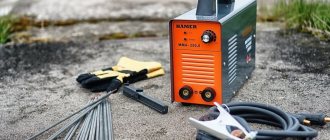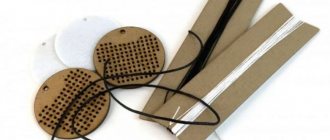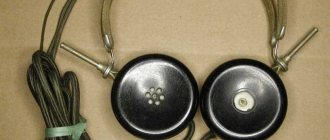Do you know that a magnet can not only be permanent, but also powered by electrical energy with the ability to turn the magnetic field on and off? So-called electromagnets are widely used in electrical engineering. You can make such an electromagnet yourself. Next, learn how to make an electromagnet at home.
How to make an electromagnet is described in detail in this manual.
Warning: the more current passes through the wire of a homemade electromagnet, the more the wire will heat up and this may even cause a fire. To reduce heat when creating an electromagnet, use thicker copper wire.
Materials:
- Telephone wire (or enameled copper cable from a transformer).
- Cable stripping tool.
- Scissors.
- Pliers.
- Type D battery (or other power source).
- Adhesive tape or glue.
- Ferrous metal core, use a steel nail or piece of pipe.
- Small iron objects for testing (screws, nails, etc.).
- Your hands.
Files
- electromagnetvid.avi
A little physics
As we remember (or don’t remember) from physics lessons, in order to convert electric current into a magnetic field, we need to create induction. Inductance is created using an ordinary coil, inside which this field arises and is transmitted to the steel core around which the coil is wound.
Thus, depending on the polarity, one end of the core will emit a field with a minus sign, and the opposite end will emit a field with a plus sign. But visual magnetic abilities are not affected in any way by polarity. So, when you are done with physics, you can begin decisive action to create a simple electromagnet with your own hands.
Technical specifications
Magnetic plates are rarely included as standard equipment in factory equipment. Most often they are purchased separately. Therefore, it is important to know their main technical characteristics, which must correspond to the parameters of a specific machine model.
The determining parameter is the dimensions. The size of the plate can vary from 10*25 cm to 32*100 cm. Moreover, as the dimensions of the device increase, its weight increases. This directly affects the maximum weight of the workpiece, since the plate is installed on a standard work table.
The main parameters that a magnetic plate should have:
- dimensions and weight. Not only width and length are taken into account, but also height. It may affect the maximum permissible part size;
- specific force of attraction. It must be uniform over the entire installation plane. Typically this parameter ranges from 50 to 120 N/cm²;
- distance between poles. This characteristic determines the minimum size of the workpiece.
During operation, the magnetic plate can change the geometry of the workpiece. Therefore, the process of installing and subsequently removing the part should be as careful as possible. You should also take into account the main disadvantage of electromagnetic models - heating of the surface during activation. This is not only the main reason for device failure, but also affects the properties of the workpiece.
The video shows an example of how a small magnetic plate works:
Materials for making the simplest magnet
First of all, we need any inductor with a copper wire wound around the core. This can be a regular transformer from any power supply. An excellent way to create electromagnets is to wind them around the narrowed back of picture tubes of old monitors or televisions. The conductor threads in transformers are protected by insulation consisting of an almost invisible layer of special varnish that prevents the passage of electric current, which is exactly what we need. In addition to the indicated conductors, to create an electromagnet with your own hands you also need to prepare:
- A regular one and a half volt battery.
- Scotch tape or tape.
- Sharp knife.
- Hundreds of nails.
The process of making a simple magnet
We start by removing the wires from the transformer. As a rule, its middle is located inside the steel frame. You can, after removing the surface insulation on the coil, simply unwind the wire, dragging it between the frames and the coil. Since we don't need a lot of wire, this method is the most acceptable here. When we have released enough wire, we do the following:
- We wind the wire removed from the transformer coil around a nail, which will serve as a steel core for our electromagnet. It is advisable to make turns as often as possible, pressing them tightly against each other. Do not forget to leave a long end of the wire at the initial turn, through which our electromagnet will be powered to one of the poles of the battery.
- When we reach the opposite end of the nail, we also leave a long conductor for powering. We cut off the excess wire with a knife. To prevent the spiral we wound from unraveling, you can wrap it with tape or tape.
- We strip both ends of the wire coming from the wound nail from the insulating varnish with a knife.
- We lean one end of the stripped conductor against the positive of the battery and secure it with tape or tape so that the contact is well maintained.
- We wind the other end to the minus in the same way.
The electromagnet is ready for use. By scattering metal clips or tacks on the table, you can check its functionality.
How to make a more powerful magnet?
How to make an electromagnet with more powerful magnetic properties with your own hands? The strength of magnetism is influenced by several factors, and the most important one is the electrical current of the battery we use. For example, by making an electromagnet from a square 4.5 volt battery, we will triple the strength of its magnetic properties. The 9-volt crown will give an even more powerful effect.
But do not forget that the stronger the electric current, the more turns will be required, since the resistance with a small number of turns will be too strong, which will lead to strong heating of the conductors. If they are heated too much, the insulating varnish may begin to melt, and the turns will begin to short-circuit to each other or to the steel core. Both will sooner or later lead to a short circuit.
Also, the strength of magnetism depends on the number of turns around the magnet core. The more there are, the stronger the induction field will be, and the stronger the magnet will be.
DIY 12V solenoid
Valves classification
Similar devices on water pipelines (as well as gas pipelines, etc.) are used for several purposes:
This does not exhaust the functionality of shut-off and control devices; they can also be used to control pumps, wastewater treatment, to minimize leaks, etc.
How to make a toy car with a solenoid motor
How to make a car with a solenoid motor
You may have seen a lot of videos about building a car with an electromagnetic motor on the Internet. There are hundreds of such videos. But this project is completely different. We designed it the way car engines work.
You can see many components similar to those in an internal combustion engine. You can see the pistons, connecting rod, crank, crankshaft, cylinder, cylinder head, flywheel, etc.
An IC motor is powered by the explosion of fuel inside the cylinder, whereas in a solenoid motor the driving force is electromagnetism.
Craftsmen buy inventions from the best Chinese online store. Car solenoid motor
A solenoid is a type of electromagnet where the purpose is to create a controlled magnetic field. If instead the purpose of the solenoid is to prevent changes in electrical current, the solenoid can be more specifically classified as an inductor rather than an electromagnet
In engineering, the term can also refer to a variety of converting devices that convert energy into linear motion.
The term is also often used to refer to a solenoid valve, which is an integrated device containing an electromechanical solenoid that operates a pneumatic or hydraulic valve, or a solenoid switch, which is some type of relay.
which uses an electromechanical solenoid internally to operate an electrical switch; for example, a car starter solenoid or a linear solenoid, which is an electromechanical solenoid. There are also electromagnetic bolts, a type of electronic-mechanical locking mechanism.
How to make a solenoid Enginen Car
Step 1: Making the Solenoid Cylinder
Step 2: Making the Piston
DIY electronics in a Chinese store.
Step 3: Making the Crankshaft
Read more about the design and principle of operation of different types of valves
Recently, in addition to conventional valves (which operate solely on the basis of the application of force), electromagnetic analogues have also appeared; they can be controlled remotely. A water solenoid valve can be used, for example, in a “smart home” system; from one remote control you can control control devices throughout the house and in the surrounding area.
Solenoid valves
The key difference from other analogues is that it does not allow water to pass through when pressure increases, but solely at the command of a person. This is their main advantage.
As for the design, the key element can be considered a coil, which, when electric current passes through it, causes the core to move, which opens/closes the passage hole. Such devices can operate either from batteries (supply voltage 24V) or connected to the network (voltage 110V or 220V).
As for classification, we can distinguish:
Note! When choosing, you need to take into account the operating features of each model. For example, if an electromagnetic shut-off device is produced with servo control, then you need to know that it simply will not work at zero pressure drop, so at least a minimum pressure drop is still needed.
As for the scope of application, electromagnetic devices fit perfectly into the “smart home” concept. For example, an electric water valve installed in a caisson will be able to drain automatically, without even having to leave the house, and this example is the simplest.
Simple and combined models
When operating a water pipeline, you have to solve problems such as:
Note! This problem especially often has to be solved when operating a heating system. All radiators require the installation of a special valve to release excess air.
A simple Mayevsky crane with manual control can handle the release of air plugs; the price of such a device does not even reach 200 rubles.
But other types of shut-off and control valves can also be used:
Note! Also, combined devices may have small holes to equalize pressure.
Drainage
A drain valve can be used not only in a house to discharge water from pipes, but also as a device to ensure the safety of water supply from a well. Such devices are similar in principle to combined air devices and in winter, when the pressure in the pipe decreases, they discharge water into the well.
When the pressure is above the minimum, the ball closes the outlet and water flows into the house. If the pressure drops below the minimum mark, the ball opens the outlet and water flows back into the well, this allows you to preserve the system when the water in the pipe freezes.
A drain valve is useful for protecting hoses and pipes of an irrigation system; such a device is especially useful when laying a separate water supply for irrigation. If the pipe is not laid very deep and there is a risk of freezing, then the drainage pipes themselves will discharge the remaining water from the system.
Of course, you can simply install a drain valve and do the same yourself, but no one can boast of perfect memory. The valve will definitely not forget to drain the water.
As for installation, a threaded (that is, detachable) connection is most often used. Most often, the entire instruction consists of tightening the union nut by hand, and then tightening it with a wrench. In industry, welded and flanged connections can be used.
Electromagnetic Gauss gun on a microcontroller
Hi all. In this article we will look at how to make a portable electromagnetic Gauss gun assembled using a microcontroller. Well, about the Gauss gun, of course, I got excited, but there is no doubt that it is an electromagnetic gun.
This microcontroller device was designed to teach beginners how to program microcontrollers using the example of constructing an electromagnetic gun with their own hands.
Let's look at some design points both in the electromagnetic Gauss gun itself and in the program for the microcontroller.
From the very beginning, you need to decide on the diameter and length of the barrel of the gun itself and the material from which it will be made. I used a 10mm plastic case from a mercury thermometer because I had one lying around.
You can use any available material that has non-ferromagnetic properties. These are glass, plastic, copper tube, etc. The length of the barrel may depend on the number of electromagnetic coils used.
In my case, four electromagnetic coils are used, the barrel length was twenty centimeters.
Making a more powerful magnet
Let's try to make a 12 volt electromagnet with our own hands. It will be powered by a 12-volt AC power supply or a 12-volt car battery. To manufacture it, we will need a much larger amount of copper conductor, and therefore we should initially remove the internal coil with copper wire from the prepared transformer. A grinder is the best way to extract it.
What we need for production:
- A steel horseshoe from a large padlock, which will serve as our core. In this case, it will be possible to magnetize the pieces of iron at both ends, which will further increase the lifting capacity of the magnet.
- Coil with copper wire in varnished insulation.
- Insulating tape.
- Knife.
- Unnecessary 12 volt power supply or car battery.
The process of making a powerful 12-volt magnet
Of course, any other massive steel pin can be used as a core. But a horseshoe from an old castle will do just fine. Its bend will serve as a kind of handle if we start lifting loads of impressive weight. So, in this case, the process of making an electromagnet with your own hands is as follows:
- We wind the wire from the transformer around one of the horseshoes. We place the coils as tightly as possible. The curve of the horseshoe will interfere a little, but that's okay. When the length of the side of the horseshoe ends, we lay the turns in the opposite direction, on top of the first row of turns. We make a total of 500 turns.
- When the winding of one half of the horseshoe is ready, wrap it with one layer of electrical tape. The original end of the wire, intended for recharge from a current source, is brought out to the upper part of the future handle. We wrap our coil on the horseshoe with another layer of electrical tape. We wind the other end of the conductor to the bending core of the handle and make another coil on the other side.
- We wind the wire on the opposite side of the horseshoe. We do everything the same as in the case of the first side. When 500 turns have been laid, we also remove the end of the wire for power supply from an energy source. For those who don't understand, the procedure is clearly shown in this video.
The final stage of making an electromagnet with your own hands is recharging to the energy source. If it is a battery, we extend the ends of the stripped conductors of our electromagnet using additional wires, which we connect to the battery terminals. If this is a power supply, cut off the plug going to the consumer, strip the wires and screw a wire from the electromagnet to each one. Insulate with electrical tape. We plug the power supply into the outlet. Congratulations. You have made with your own hands a powerful 12-volt electromagnet that is capable of lifting loads over 5 kg.
How to make a simple electromagnet - step-by-step instructions with diagrams
Such a device is convenient because its operation is easy to control using electric current - changing the poles, changing the force of attraction. In some matters it becomes truly indispensable, and is often used as a constructive element of various homemade products. It’s not difficult to make a simple electromagnet with your own hands, especially since almost everything you need can be found in every home.
What you will need
- Any suitable sample made of iron (it is highly magnetic). This will be the core of the electromagnet.
- The wire is copper, always with insulation to prevent direct contact of the two metals. For a homemade electric magnet, the recommended cross-section is 0.5 (but not more than 1.0).
- DC source - battery, battery, power supply.
Additionally:
- Connecting wires for connecting an electromagnet.
- Soldering iron or electrical tape to secure contacts.
This is a general recommendation since the electromagnet is made for a specific purpose. Based on this, the components of the circuit are selected.
And if it is done at home, then there cannot be any standard - whatever is at hand will do.
For example, in relation to the first point, a nail, a lock shackle, or a piece of iron rod are often used as a core - the choice of options is huge.
Winding
The copper wire is carefully wound onto the core, turn by turn. With such scrupulousness, the efficiency of the electromagnet will be the maximum possible.
After the first “pass” along the iron sample, the wire is laid in a second layer, sometimes a third. It depends on how much power the device requires.
But the direction of winding must remain unchanged, otherwise the magnetic field will become “unbalanced”, and the electromagnet will hardly be able to attract anything to itself.
To understand the meaning of the ongoing processes, it is enough to remember the physics lessons from the high school course - moving electrons, the EMF they create, the direction of its rotation.
After winding is completed, the wire is cut so that the leads can be conveniently connected to the power source. If it's a battery, then directly. When using a power supply, battery or other device, you will need connecting wires.
What to consider
There are certain difficulties with the number of layers.
- As turns increase, reactance increases. This means that the current strength will begin to decrease, and the attraction will become weaker.
- On the other hand, increasing the current rating will cause the winding to heat up.
The operating principle of the electromagnet is described in detail in the following video:
Connection
- Cleaning the copper terminals. The wire is initially coated with several layers of varnish (depending on the brand), and it is known to be an insulator.
- Soldering copper and connecting wires. Although this is not essential, you can twist it by insulating it with a PVC pipe or adhesive tape.
- Fixing the second ends of the wires on the clamps. For example, the “crocodile” type. Such removable contacts will allow you to easily change the poles of the electromagnet, if necessary during its use.
Useful tips
- To make a powerful electromagnet, home craftsmen often use a coil from an MP (magnetic starter), relays, or contactors. They are available for both 220 and 380 V.
It is not difficult to select an iron core based on its internal cross-section. For ease of control, you need to include a rheostat (variable resistance) in the circuit. Accordingly, such an electric magnet is already connected to the outlet.
The force of attraction is regulated by changing the R chain.
- You can increase the power of an electromagnet by increasing the cross-section of the core. But only up to certain limits. And here you have to experiment.
- Before making an electric magnet, you need to make sure that the selected iron sample is suitable for this. The check is quite simple. Take a regular magnet; There are a lot of things in the house on such “suction cups”. If it attracts the part selected for the core, it can be used. If the result is negative or “weak,” it is better to look for another sample.
Making an electromagnet is quite simple. Everything else depends on the patience and ingenuity of the master. You may have to experiment to get what you need - with the supply voltage, wire cross-section, and so on. Any homemade product requires not only a creative approach, but also time. If you do not regret it, then an excellent result is guaranteed.











